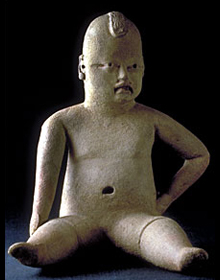resources
Museum Collections - Mesoamerica - Olmec - Artifact #1

WHO: Olmec style
WHERE: Central Mexico
WHEN: Middle Preclassic Period, 1100 - 800 B.C.
WHAT: Hollow clay figures like this one are commonly referred to as "baby-faces" because of the plumpness of the limbs and the infant-like poses. They are quite distinctly Olmec in style and inspiration, but as a form were widespread in Mexico during the Preclassic Period. This particular example likely came from the early settlement of Tlapacoya, which was in the northern part of the Valley of Mexico. As with most seated "baby-faced" figures, this one is not wearing clothes. The plump arms and legs, small feet, and almond-shaped eyes are characteristic of the Olmec style.
Height: 23.8cm
HOW: Coil-built and hand-modelled buff earthenware with traces of red pigment.
MUSEUM: Gardiner Museum of Ceramic Art. G83.1.11
Zoomify Interactive: To see an image of this artifact that you can zoom in on, click on this link: Front (Warning: This link will open in a new window)
